- TOP
- Search Criteria
- Sharing Kansai Brands with the World: Hanayaka Kansai Selection 2016
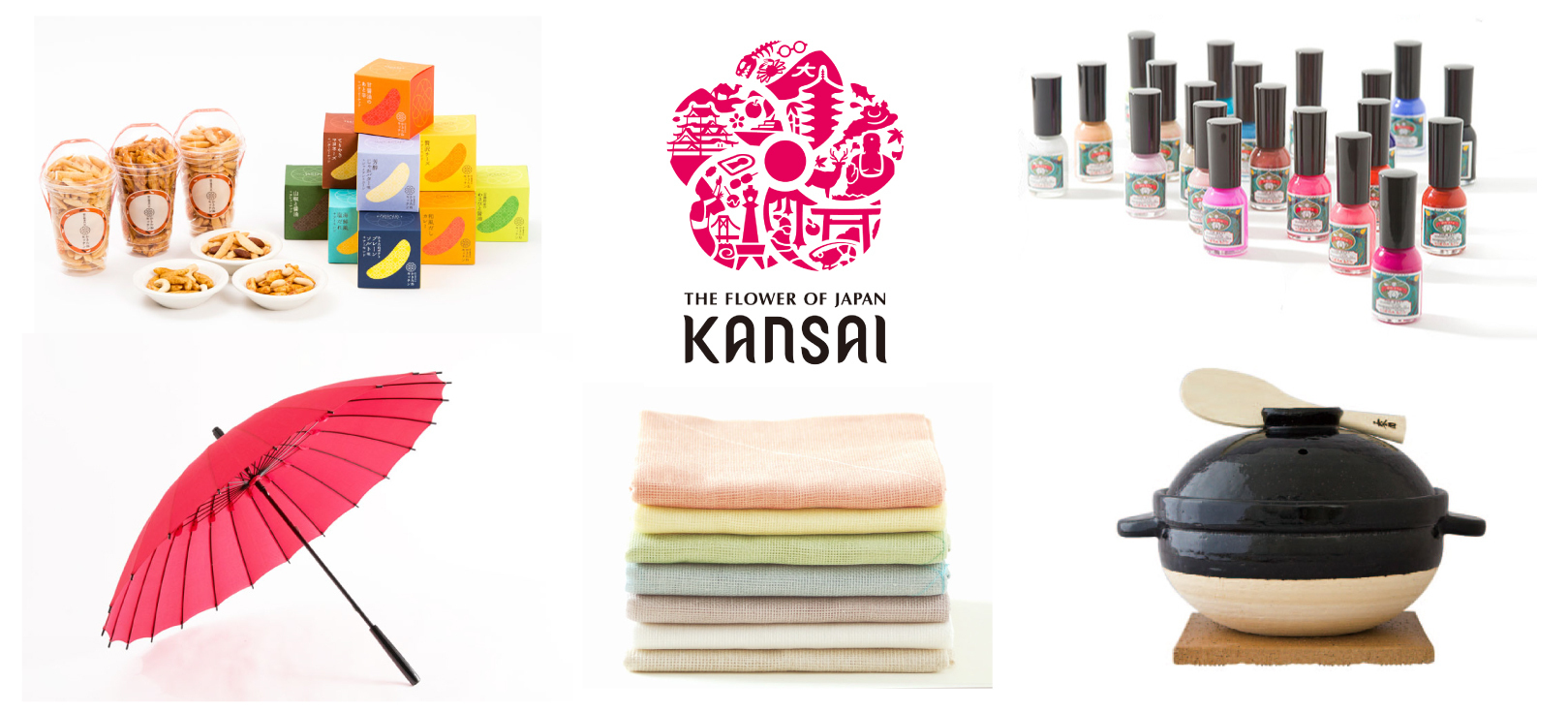
STORY
Sharing Kansai Brands with the World: Hanayaka Kansai Selection 2016
The items were judged on the following five criteria.
- That the item represent the future vision for the area rather than its past or present,
- That the item address a challenge of today using the characteristics of the area
- That the item encourage conversation
- That the item appeal with its authentic character to foreign tourists who have discriminating tastes
- That the item have a story which includes the area, its history, and the intentions of the designer
Out of these five criteria, it was of particular importance that the item have a well-woven story. The value of these items as souvenirs isn’t just about the thing itself, but the memories and the desire to return to the area that it invokes.
Hanayaka Kansai Selection 2016
Janome Yougasa (by Fukui Yougasa in Fukui Prefecture)

The image of a deep crimson umbrella invokes thoughts of Japan. These traditional-style umbrellas are often seen in period dramas or films set in Japan, but these beautiful items are not exclusively property of the past. In Fukui Prefecture, one company is producing fine umbrellas that are not only high in artistic value, but are well suited for practical use.
Located in Fukui Prefecture, Fukui Yougasa has taken the Janome, a type of umbrella with more than four hundred years of history, and updated it to fit the needs of modern life. Each umbrella is crafted by hand by skilled craftsmen. The framework of the umbrella makes use of Fukui Prefecture’s long history of manufacturing glasses frames to produce a sturdy yet beautiful structure of twenty-four ribs.
Information
Janome Yougasa | 蛇の目洋傘By Fukui Yougasa Co., Ltd.
Address: 4-4-2 Hamabessho-cho, Fukui-shi, Fukui-ken
Website: http://www.fukuiyougasa.com/en/
Kamadosan (by Nagatani Seito Co., Ltd. in Mie Prefecture)
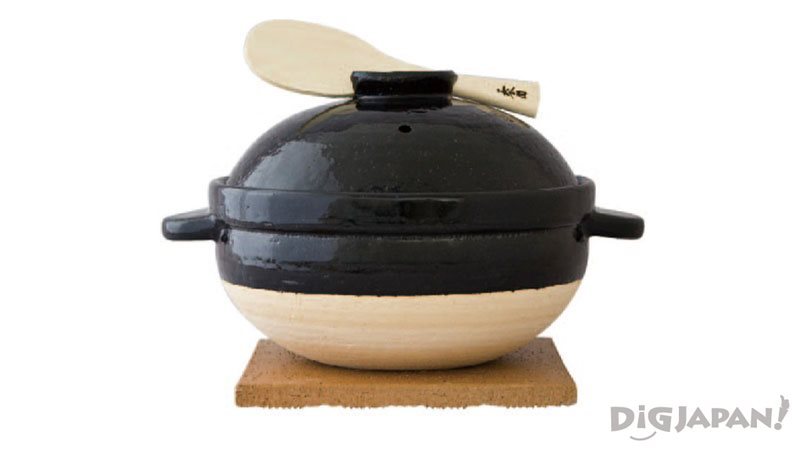
While the efficiency of Japanese electric rice cookers make them a popular buy even among tourists from abroad, enjoying the exceptional taste of rice prepared in an earthenware pot called a donabe shouldn't be missed. Right now there’s a type of donabe called Kamadosan that’s particularly popular in Japan.
There are two points that make the Kamadosan particularly attractive. One is that you don't need to monitor the strength of the heat used to cook the rice as you would with other types of pots. The second is that rather than boiling the rice as many rice cookers do, the Kamadosan’s glazing traps the heat in a way that produces delicious rice with minimal effort. Plus, the design of the Kamadosan is so sophisticated that you can bring the whole pot to your table and serve directly from it.
Information
Kamadosan | かまどさん
By Nagatani Seito Co., Ltd.
Address: 569 Marubashira, Iga-shi, Mie-ken
Website (Japanese only): http://www.igamono.co.jp
Reed-Calligraphy Pen ReEDEN (by KOKUYO Product Shiga Co., Ltd. in Shiga Prefecture)

While Japanese calligraphy pens are already quite popular abroad, particularly in the West, the Reed-Calligraphy Pen ReEDEN is worth a look. Made one-by-one by artisans, these calligraphy brushes are crafted from carefully selected natural yoshi, a plant similar to rice plants. The particular yoshi used for these brushes comes from the areas around Lake Biwa and the Yodogawa River, which are harvested in ways that are safe for the local environment. Careful attention is paid to the creation of the brush from body to tip. The brush is packaged in an elegant box made of paulownia wood and comes with extra ink, making it a perfect gift that can be used for many, many years even if the recipient lives outside of Japan.
Information
Reed-Calligraphy Pen ReEDEN | ヨシ筆ペンReEDEN
By KOKUYO PRODUCT SHIGA CO., LTD.
Address: 312 Kamigano, Aisho-cho, Echi-gun, Shiga-ken
Website (Japanese only): https://www.kokuyo-shiga.co.jp/
Gofun Nail Polish (by Uebaesou Co., Ltd. in Kyoto Prefecture)
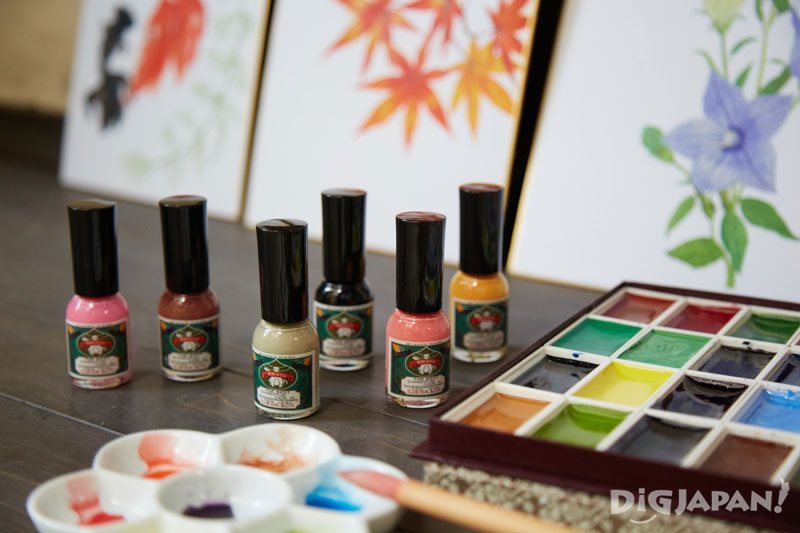
If you're looking to bring a sophisticated Japanese style to your manicure, then Gofun Nail Polish is the perfect fit for you. Developed by the oldest paint shop in Kyoto, these nail polishes are made from a base of finely powdered scallop shell called gofun in Japanese. This is a traditional base for Japanese paints. It is very gentle on nails and also gives the polish a beautiful shine.
These nail polishes come in a variety of colors based on things in the natural world such as the sun or the moon, peaches and strawberries, all of which carry a distinctly Japanese feel. Choose a variety of colors to bring to friends and family back home.
Information
Gofun Nail Polish | 胡粉ネイルBy UEBAESOU CO., LTD.
Address: 579 Toro-cho, Higashinotoin Doori Takatsuji Sagaru, Shimogyo-ku, Kyoto-shi, Kyoto
Website (Japanese site): https://www.ueba.co.jp
English information page: https://www.gofun-nail.com/ueba/english/gofunnnailenglish.htm
Takaradzukushi Monaka (by Namiyoshian in Osaka Prefecture)

A traditional Japanese confection, monaka is a kind of thin wafer made from mochi. These particular monaka come shaped like one of six different items from Japanese culture such as the lucky tai or sea bream, an old type of currency called a koban, daruma dolls, maneki neko, and so on. With this set, you fill up these monaka shells yourself with delicious tsubuan red bean paste. Additionally, each different shell comes with its own little fortune, so choosing the shape you like becomes even more fun! The main store in Osaka has a cafe with a space where you can make your own dango dumplings, so be sure to stop by when you visit the Kansai area.
Information
Takaradzukushi Monaka | 宝づくし最中By Namiyoshian Co., Ltd.
Address: 1-7-31 Shikitsuhigashi, Naniwa-ku, Osaka-shi, Osaka
Website (Japanese only): http://www.namiyoshian.jp
Roots Shawl (by Tamaki Niime in Hyogo Prefecture)
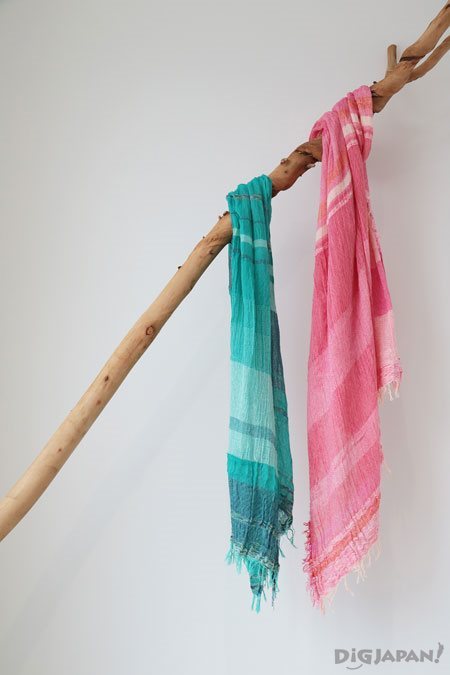
With one touch, you'll be captivated by the softness of the roots shawl made by designer Tamaki Niime. Ms. Niime moved to Kitaharima, an area of Hyogo Prefecture known for a style of weaving called banshu-ori in which the threads are first dyed and then woven so as to create a variety of patterns. She makes her brightly colored shawls in small batches, each an individual work of art. The texture of these pieces only improves with age, meaning these shawls will be a treasured item in your wardrobe for years to come.
Information
Roots Shawl | ルーツショールBy tamaki niime
Address: 550-1 Hie-cho, Nishiwaki-shi, Hygo-ken
Website: http://niime.jp/
Design Setta SANGO(by DESIGN SETTA SANGO Inc. in Nara Prefecture)

It’s said that the town of Sango in Nara Prefecture has been producing zori and leather-soled setta sandals since the Edo period. During the heyday of this style of footwear, it’s said that Sango was responsible for producing an astonishing eighty percent of all zori and setta. As lifestyles and fashions began to change in Japan, the craftsmen of Sango started to design new types of setta sandals that matched the needs of the time.
The eye-catching straps of these leather-soled sandals are made from vintage fabrics from Europe for a modern design. The base of the sandal is made from the same natural material usually used to make bags for storing coffee beans. These sandals are handcrafted by skilled artisans who pay as much attention to the aesthetics of the sandals as they do to the level of comfort they provide their wearer. Whether paired with jeans or a skirt, these eye catching sandals go great with any casual look.
Information
Design Setta SANGOBy DESIGN SETTA SANGO Inc.
Address: 1-24-5 Tatsunominami, Sango-cho, Ikoma-gun, Nara-ken
Website: http://designsetta.jp/en
Umeshu Haruka (by Kawamoto Shokuhin in Wakayama Prefecture)
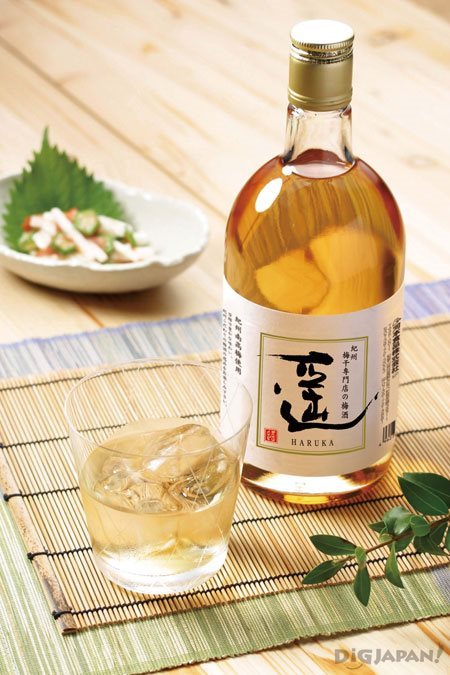
From craftsmen well versed in the qualities of a type of ume, or Japanese apricot, called kishu nanko comes Haruka umeshu. This unique plum wine is made by steeping Kishu Nanko ume in brandy with sugar. The result is an easy to drink plum wine that is both refreshing and rich; and because no artificial flavors or colors are added, the finish is surprisingly crisp and pleasant.
Foreign tourists looking for authentic Japanese products are sure to take an interest in this plum wine, which is produced by a shop specializing in additive-free umeboshi or pickles plums. Furthermore, the elegant label with the kanji for Haruka written on it in by brush is very pleasing to the eye.
Information
Umeshu Haruka | 梅酒遥By Kawamoto Shokuhin K.K.
Address: 367-1 Kisato, Minabe-cho, Hidaka-gun, Wakayama-ken
Website (Japanese only): http://www.kawamotokk.co.jp/item_umeshu-haruka.html
Chiyomusubi Junmai Daiginjo Goriki 40 (by CHIYOMUSUBI SAKE BREWERY CO., LTD. in Tottori Prefecture)
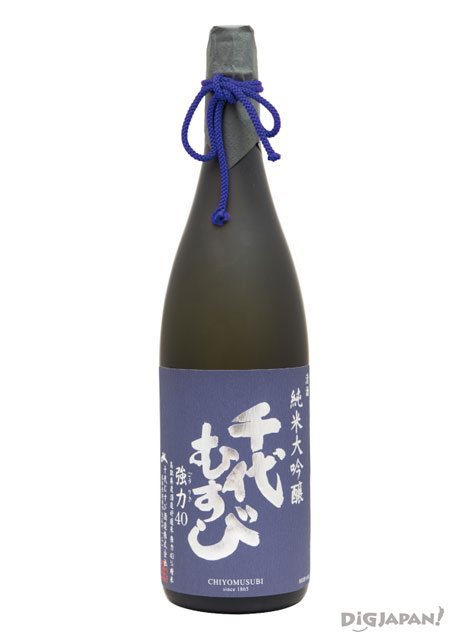
Chiyomusubi takes Goriki rice, a type of rice used for making nihonshu that is only found in this region, and polishes it until there is only forty percent of the grain remaining to make this particular nihonshu. The result is a unique product with a gentle fragrance and an elegant taste.
The qualities of this nihonshu are strongly influenced by the ingredients. Goriki rice is very difficult to cultivate; in fact, its cultivation was once abandoned because of those difficulties. Now its use has been revived. Using this unique type of rice combined with local water makes for a truly one-of-a-kind “local” nihonshu that brings with it the heart of the region.
Information
Chiyomusubi Junmai Daiginjo Goriki 40 | 千代むすび純米大吟醸強力40By CHIYOMUSUBI SAKE BREWERY CO., LTD.
Address: 131Taisho-machi, Sakaiminato-shi, Tottori-ken
Website: http://www.chiyomusubi.co.jp/index_eng.html
Aizome Uchiwa Fan Danzome (by Awagami Factory/Fuji Paper Mills Cooperative in Tokushima Prefecture)

Information
Aizome Uchiwa Fan Danzome | 藍染めうちわ段染めBy Awa Hand-made Japanese Paper
Commercial and Industrial Cooperative (Awagami Factory)
Address: 141 Kawahigashi, Yamakawa-cho, Yoshinogawa-shi, Tokushima-ken
Website: http://www.awagami.com/
The three special prizes
Kakitane from Kakitane Kitchen (by TOYOSU CO., LTD. from Osaka Prefecture)
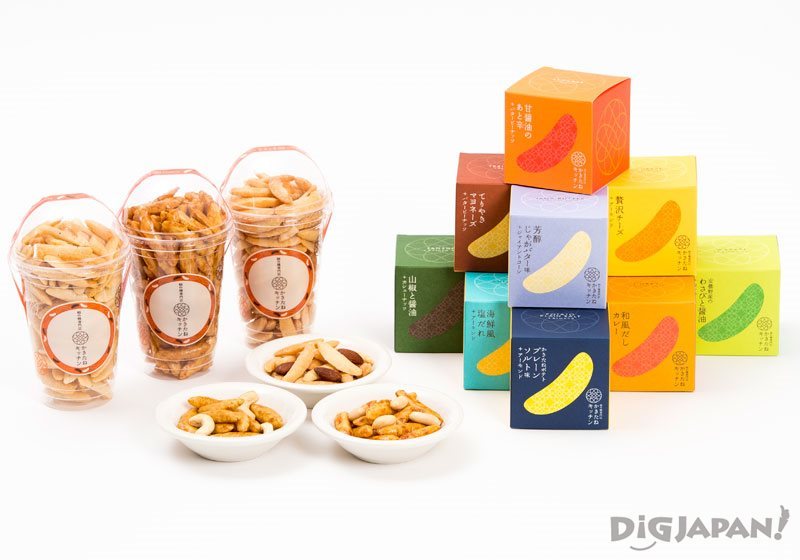
Kakitane or kaki no tane are a type of chip made in the shape of a persimmon (kaki) seed (tane). What sets the kakitane from Kakitane Kitchen apart, run by famous Osakan store Toyosu, is the novel flavors they give their high-quality snacks. Options include ume-wasabi, seafood sauce, butter potato, Japanese-style curry, teriyaki mayonnaise, and more.
With bright colors and cute designs, the packaging used by Kakitane Kitchen has as much personality as the snacks it contains. This makes them an appealing souvenir to both give and receive.
Information
Kakitane from Kakitane Kitchen | かきたねキッチンのかきたねBy TOYOSU CO., LTD.
Address: 1-3-11 Sumiyoshi, Ikeda-shi, Osaka
Website (Japanese only): http://www.toyosu.co.jp/kakitanekitchen/
Katayaki (by Iga Kaan Yamamoto from Mie Prefecture)

Also called the “ninja sweet,” katayaki are said to have been the food of Iga's ninja. They were portable, stayed good for long periods of time, and were an essential preserved food in areas of conflict. The ingredients used in these modern katayaki are simple: flour, sugar, and sesame seeds. They are also additive-free, making them a good choice for a quality snack. These famous sweets from the Iga region are mildly sweet in both taste and aroma and have a satisfying crunch. Learning about the origins of the Iga ninja as well as breaking the sweet into pieces before eating it with a small wooden hammer make this a particularly fun Japanese sweet!
Information
Katayaki | かたやきBy Iga Kaan Yamamoto LCC
Address: 2887-2 Uenouo-machi, Iga-shi, Mie-ken
Website (Japanese only): http://www.katayaki.co.jp/katayaki/index.htm
Yu Nakagawa Hana Fukin (by Nakagawa Masashichi Shoten Co., Ltd. in Nara Prefecture)
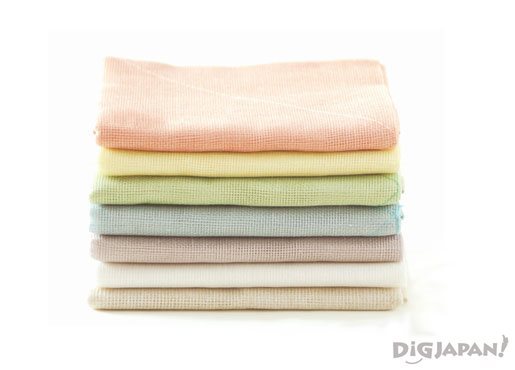
These hana fukin or flower dish cloths are large and thin. Fold them over to use and simply unfold and hang to dry. Despite their excellent absorbency, they dry out surprisingly quick!
Information
Yu Nakagawa Hana Fukin | 遊中川 花ふきんBy Nakagawa Masashichi Shoten Co., Ltd.
Address: 1112-1 Tokujo-cho, Nara-shi, Nara
Website: http://www.yu-nakagawa.co.jp/en/
The Hanayaka Kansai Symbol
The presence of this pink symbol indicates that a product is the recipient of a Hanayaka Kansai Selection 2016 award. Be on the lookout for it when shopping at Kansai International Airport or at souvenir shops!

Liked this story? Like DiGJAPAN!
on Facebook for daily updates!
THIS ARTICLE IS BASED ON INFORMATION FROM 02 10,2017 Author:DiGJAPAN! Editorial Team













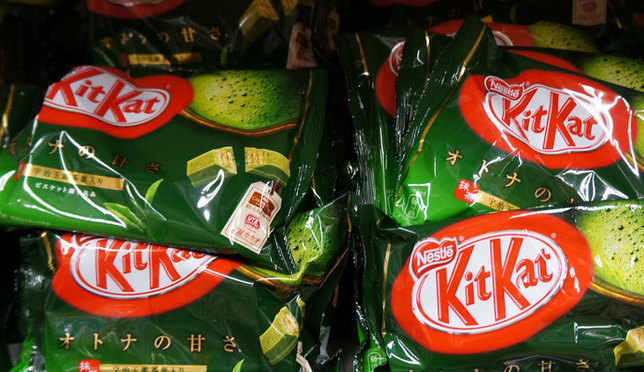
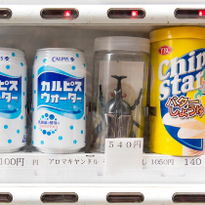

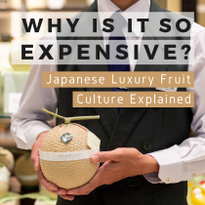





NEW COMMENT | 0 COMMENTS
Open a DiGJAPAN!
account to comment.
Open a DiGJAPAN! Account